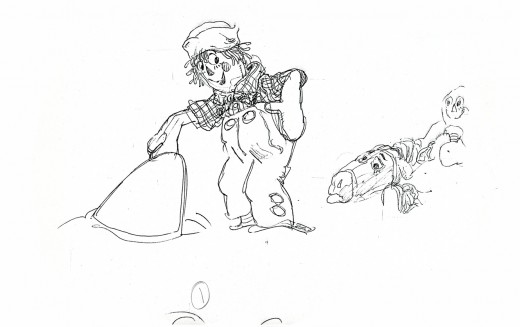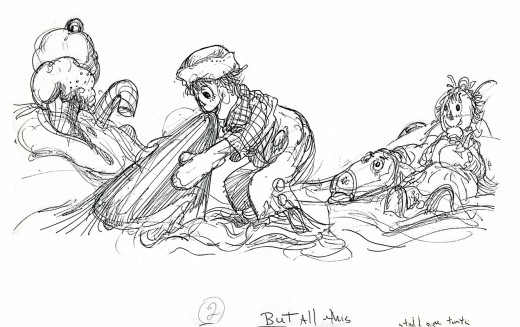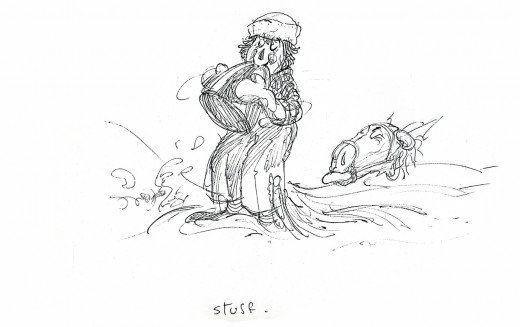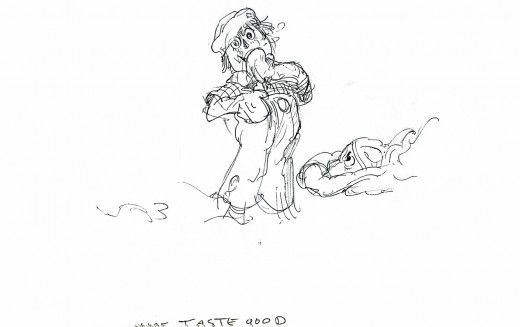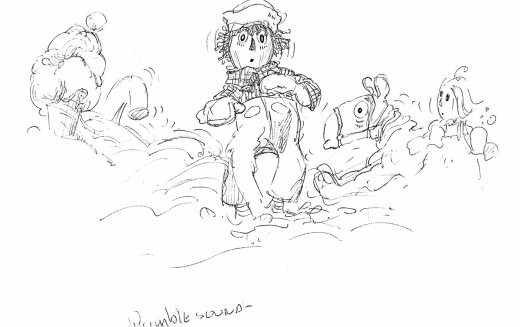Category ArchiveRichard Williams
Animation &Animation Artifacts &Richard Williams 12 Oct 2006 07:54 am
Andy & Corny
- Seeing the models David Nethery posted on his site, You’re A Gazelle, in his comments on Tissa David‘s work from Raggedy Ann, started me thinking about the Dick Williams‘ film. As I noted, yesterday, I have quite a bit of artwork from the film, and I thought I should post some.
I think in ways, the unsung hero of Raggedy Ann was Corny Cole. He was there from day one working with Dick and Tissa – once the one minute pilot had gotten the job for Dick. Corny was brought in as the key designer, and Gerry Potterton came on as Dick’s Associate Director.
I was hired soon thereafter, even though I had no idea what I’d be doing. For the first couple of weeks, while they were recording, I just moved furniture and read the script and whiled away the time by drawing Johnny Gruelle‘s characters.
I helped Dick and Gerry add spot coloring to the storyboard as the animatic was being shot. We spent a long Saturday coloring like mad with colored pencils. We worked on the last section of the animatic to be shot. I’d say 90% of the board was done by Corny. Dick and Gerry added spot drawings as needed, while we built the animatic.
Corny then did lots and lots and lots of drawings to give to animators.
Some of those drawings are posted herein for a scene at the beginning of the “taffy pit” sequence. These drawings were also used in the animatic.
After Corny finished feeding the animators, he started animating, himself. He took on a sequence that filled the screen with a pirate ship full of dolls floating around some rough waters. The large sheets of paper were filled with Corny’s black bic pen lines. Doug Compton eventually worked with Corny to finish this overworked sequence.
Animation &Hubley &Richard Williams 08 Apr 2006 08:33 am
Rambling Rambling
To put it in a nutshell:
Back in the early ’60′s animation busted out of the studios. The Hubley surprise Tender Game of 1958 was followed by Moonbird in 1959. Suddenly people realized full well that they could use this medium to do more than make people laugh – and they could do it Independently and out of schools and on a shoestring. Annecy and Zagreb showed up to show the films, and a new world was born from the remains of UPA.
Dick Williams did The Little Island. George Dunning did The Flying Man. Borowczyk and Lenica did Dom. Fred Wolf did The Top. Bruno Bozzetto did The Two Castles. The Zagreb studios grew wildly and quickly and made exciting films.
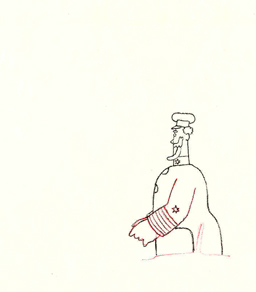 – The first feature to capitalize on this 60′s renaissance of animation (excluding Hubley’s own feature Of Stars and Men) and rehash what had been done by the Independent crowd, was The Yellow Submarine.
– The first feature to capitalize on this 60′s renaissance of animation (excluding Hubley’s own feature Of Stars and Men) and rehash what had been done by the Independent crowd, was The Yellow Submarine.
The Beatles sponsored something just this side of daring. However, those of us in the know were aware that it had already been done in shorts. We’d seen it in festivals. We’d seen it at ASIFA. The modest success of that feature made it more mainstream, and it wasn’t long before Beavis and Butthead came along.
- I remember the streets of New York lined with cels from The Yellow Submarine. Every Manhattan stationery sold them. Marketing. Those cels stayed in store windows for years, it seemed. (click on image to enlarge.) For the most part, they were selling for $75.
I remember not thinking they were worth it.
Today, of course, they sell for $1000 and up, but then it’s probably the same difference given the value of money today.
- I’m glad to see that Bruno Bozzetto will have a retrospective in Ottawa. It was in Ottawa in 1978 that his feature Allegro Non Troppo was a surprise midnight screening. An instant hit with that crowd. No advance publicity had us all walking on heaven when that film ended. I can still remember the bubbling enthusiasm when we left the theater at 1:30am. It was an animator’s delight. It’ll be nice to see the return to Ottawa.
(New Yorkers will have a special ASIFA East meeting to honor Bozzetto and see his films just prior to Ottawa in September.)
Richard Williams &Theater 29 Jan 2006 07:44 am
Apple Tree and Aronson
Broadway Rhythms:
Broadway entered my life a long time ago. After seeing a BBC tv special, a tour of Richard Williams‘ Soho studio, I learned about his animated titles for A Funny Thing Happened On The Way To The Forum. Seeing the film, reintroduced me to Tony Walton‘s name. I knew his name from Mary Poppins where he acted as a “design consultant” for sets & costumes.
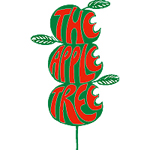 When the musical, The Apple Tree, opened on Broadway in 1967, I went. Richard Williams had designed an animated piece that illustrated the rise to super-stardom of Barbara Harris‘ character, Passionella. A young Alan Alda also starred in the show. Robert Klein was in one of his first shows.
When the musical, The Apple Tree, opened on Broadway in 1967, I went. Richard Williams had designed an animated piece that illustrated the rise to super-stardom of Barbara Harris‘ character, Passionella. A young Alan Alda also starred in the show. Robert Klein was in one of his first shows.
It was the set and the costumes that I really took home with me. I became a new fan of musical theater and at least as much a fan of Tony Walton‘s work.
the logo designed by Dick Willliams
It took another three years before I found a musical to top that experience. Company was my first Stephen Sondheim show. In 1970, suddenly, theater had grown up for me. The story, songs and direction were sophisticated, urbane, and intelligent. The set by Boris Aronson had challenged everything I knew and took it to a new level. Chrome, glass, elevators and projections. The set seemed to constantly reconstruct itself and shift to something else: an apartment complex, an apartment, a disco, a bedroom, 42nd Street. It was all of these things with the help of my imagination.
I saw this show five times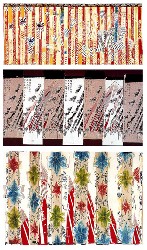 over the course of its run. For a young student, this was a large financial investment on my part, but I was hooked on Boris Aronson and planned to follow his work religiously.
over the course of its run. For a young student, this was a large financial investment on my part, but I was hooked on Boris Aronson and planned to follow his work religiously.
Pacific Overtures (the original production in 1976) took theater to another level of sophisitcation. Aronson‘s set was overwhelming for me, and completely integral to this show. It was as much an necessary part of the show as the brilliant writing, songs, and direction.
He brought pre-Industrial Japan to the stage and moved the characters into the Industrial revolution. Aronson gave us dragons that were warships, a tree that expanded to a Japanese fan, a small meeting house and a throne room. We saw the simplicity of the culture and the complexity of 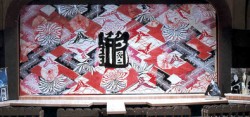 the big changes dev-
the big changes dev-
eloping.
-
Aronson designed several curtains for this production. The final one used is depicted on the left in a photo of the model.
In 1981 Richard Williams introduced me to Tony Walton. Tony needed a character animated for the show, Woman of the Year. They’d planned on six minutes of animation in the show; I ended up producing roughly 12 minutes in six weeks. The key spot was a song and dance duet that lead actor, Harry Guardino, would do with the character, Katz. Tony Charmoli danced a number he had choreographed for me, and I filmed it with a 16mm camera. We started animating.
There was no time for Pencil Tests. We did it, and I raced to Boston to put it into the show’s try-outs there. It took another couple of days for the actors to rehearse the dance with the film, and I saw it in front of a live audience for my first viewing. They loved it.
Immediately, more animation was added to the show: several short sequences which allowed for set changes, behind the screen. Two weeks before opening, writer Peter Stone, composers Kander & Ebb, and director Robert Moore had concocted a new song and dance which would open the second act. I had to have it ready for the Broadway opening. I did, but there wasn’t enough time for Harry Guardino to rehearse with the animation. The number was cut.
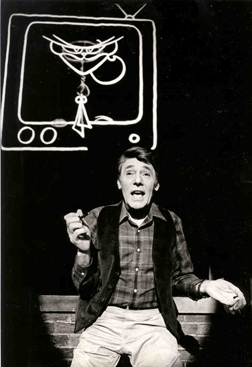
Bran Ferren was a technical genius I met and first worked with on this show. He was credited with designing “projections” for the show. He did a lot more.
The film was rear-screen projected. This meant I had to animate everything in a flopped postion. The projector was up and projected down, and it was only about six feet from the 42 foot screen. The film keystoned like a large triangle. I had to draw the piece in a reverse keystone to accomodate for the technical problem.
Our sound track had to have two tracks completely separated: on one, the voice went to the audience; on the other, a click-track went to the conductor. Since dolby had some leakage of one track to the next, Bran created a new form of dbx processing for the optical track. It was a technical nightmare that the audience never saw.
Here, a character animates to life behind Harry Guardino as he sings about the creation of it. – photo by Martha Swope
The seemingly chaotic and hectic world of Broadway was a delight. There was little money in it and less time, but I loved every second.
I gained an endless amount of respect for Tony Walton and the brilliant design he contributed, as he has done for every piece he’s created. I also found that there wasn’t a far distance between the designers of live theater and those of animation. Obviously, the link is closer with puppet animation (sets, costumes, et. al. ), but as one who has been there I don’t feel that wide a gap. There are just different needs all in pursuit of art for an audience. I’ve learned a lot from the set design and production of live theater, and this I’ve applied to my films.
I still closely follow Tony Walton‘s career and work as I have watched numerous brilliant designers over the years. Theater has often enlightened some bits of my animation work, and I encourage everyone to see as much live theater as possible.
Animation Artifacts &Richard Williams 25 Dec 2005 07:31 am
God bless us every one!

“God bless us every one!” said Tiny Tim, the last of all.
